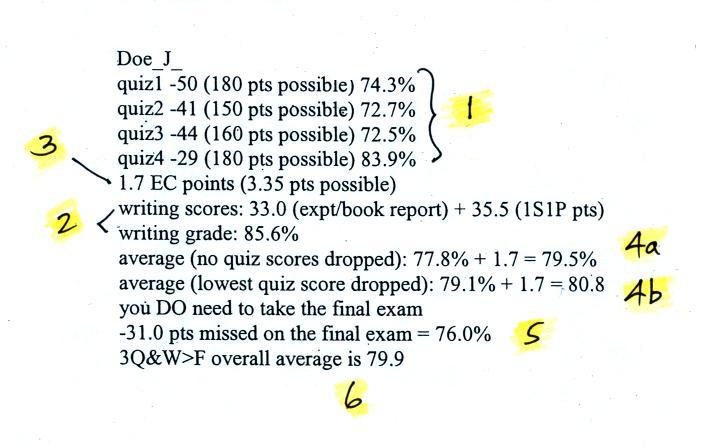
The4 quiz grades are shown in Part 1.
At Point 2 you can see the average student scored 33 out of 40
on the experiment report and earned 35.5 1S1P pts (out of the
45 points possible). This resulted in a writing
percentage grade of 85.6%.
The average student earned 1.7 extra credit points (3.35 pts were possible). This is shown at Point 3.
Point 4a shows the average of the 4 quizzes and the writing grade with the extra credit points added on. This is the average that has to be 90.0% or above to get out of the final exam. If that doesn't happen you will have to take the final exam but the average will be recomputed with the lowest quiz score dropped. That average is shown at Point 4b.
If you do well on the final exam it will count 40% of your overall grade (trying to maximize the benefit it can have). If you don't do so well on the final it only counts 20% (minimizing the damage it can cause). In this example the final exam score (76%) was lower than the semester average (80.8%) so the final only counted 20%. The overall score ended up 79.9. I would probably round this up to 80% and give this student a B. That wouldn't be a sure thing, however. If the student had earned just an additional 0.1 pts of extra credit or a few more 1S1P pts a B grade would have been assured.
The average student earned 1.7 extra credit points (3.35 pts were possible). This is shown at Point 3.
Point 4a shows the average of the 4 quizzes and the writing grade with the extra credit points added on. This is the average that has to be 90.0% or above to get out of the final exam. If that doesn't happen you will have to take the final exam but the average will be recomputed with the lowest quiz score dropped. That average is shown at Point 4b.
If you do well on the final exam it will count 40% of your overall grade (trying to maximize the benefit it can have). If you don't do so well on the final it only counts 20% (minimizing the damage it can cause). In this example the final exam score (76%) was lower than the semester average (80.8%) so the final only counted 20%. The overall score ended up 79.9. I would probably round this up to 80% and give this student a B. That wouldn't be a sure thing, however. If the student had earned just an additional 0.1 pts of extra credit or a few more 1S1P pts a B grade would have been assured.
We did cover a little course material in
class today just so you can get an idea of how that will work.
If we were using a book we'd
start in Chapter 1 and here's some of what we would be
looking at first in this course.

We had enough time today to look at the first question, the composition of the atmosphere.
Before we do that however, here are a few questions to get you thinking about the air around you. This is an example of extra information that I stick in the online notes even though we didn't cover it in class. That's something I warned you about in class.
Can you see air?

Air
is
mostly clear, transparent, and invisible (that would be
true of the air in the classroom). Sometimes the air
looks foggy, hazy, or smoggy. In these cases you are
"seeing" small water droplets or ice crystals (fog) or
small particles of dust or smoke (haze and smog).
The particles themselves may be too small to be seen with
the naked eye but are visible because they scatter
(redirect) light. I didn't really mention or explain
what that is but it's a pretty important concept and we
will learn more about it in a week or so.
And actually air isn't really invisible. If you shine a bright light through enough air, such as when sunlight shines through the atmosphere, the air (the sky) appears blue. This is a little more complicated form of scattering of sunlight by air molecules. We'll come back to this later as well.
And actually air isn't really invisible. If you shine a bright light through enough air, such as when sunlight shines through the atmosphere, the air (the sky) appears blue. This is a little more complicated form of scattering of sunlight by air molecules. We'll come back to this later as well.
Can you smell air?

Natural gas (methane) used in hot water heaters, some stoves, and furnaces is odorless. A chemical (mercaptan) is added to natural gas so that you can smell it and know when there is a leak before it builds up to a concentration that could cause an explosion.
Can you feel air

It is harder
to answer this question. We're always in contact
with air. Maybe we've grown so accustomed to it we
aren't aware of how it feels. We can certainly feel
whether the air is hot or cold, but that have more to do
with energy exchange between us and our
surroundings. And we can feel wind.
In a week or two we will see that, here in the classroom, air pressure is pressing on every square inch of our bodies with 12 or 13 pounds of force. If that were to change suddenly I'm pretty sure we'd feel it and it would probably really hurt.
Now back to material we did cover in class.
What are the 5 most abundant gases in air?
Let's start with the most abundant gas in the atmosphere. I poured some of this same material (in liquid form) into a styrofoam cup. Here's a photo I took back in my office.

You can see the liquid, it's clear, it looks like water. At least one student (probably many more) knew that this was liquid nitrogen.
The most abundant gas in the atmosphere is nitrogen. We'll use liquid nitrogen in several class demonstration this semester mostly because it is very cold (-320 F).
Nitrogen was discovered in 1772 by Daniel Rutherford (a Scottish botanist). Atmospheric nitrogen is relatively unreactive and is sometimes used to replace air in packaged foods to preserve freshness. You don't need to worry about details like this for a quiz.
Oxygen is the second most abundant gas in the atmosphere. Oxygen is the most abundant element (by mass) in the earth's crust, in ocean water, and in the human body.
In a week or two we will see that, here in the classroom, air pressure is pressing on every square inch of our bodies with 12 or 13 pounds of force. If that were to change suddenly I'm pretty sure we'd feel it and it would probably really hurt.
Now back to material we did cover in class.
What are the 5 most abundant gases in air?
Let's start with the most abundant gas in the atmosphere. I poured some of this same material (in liquid form) into a styrofoam cup. Here's a photo I took back in my office.

You can see the liquid, it's clear, it looks like water. At least one student (probably many more) knew that this was liquid nitrogen.
The most abundant gas in the atmosphere is nitrogen. We'll use liquid nitrogen in several class demonstration this semester mostly because it is very cold (-320 F).
Nitrogen was discovered in 1772 by Daniel Rutherford (a Scottish botanist). Atmospheric nitrogen is relatively unreactive and is sometimes used to replace air in packaged foods to preserve freshness. You don't need to worry about details like this for a quiz.
Oxygen is the second most abundant gas in the atmosphere. Oxygen is the most abundant element (by mass) in the earth's crust, in ocean water, and in the human body.
 |
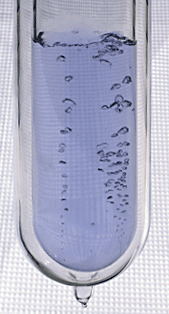 |
| from: http://www.webelements.com/oxygen/ The web elements site credits Prof. James Marshall's Walking Tour of the Elements. |
from: http://en.wikipedia.org/wiki/Oxygen Wikipedia credits Dr. Warwick Hillier of Australia National University |
A couple of photographs of liquid oxygen
are shown above. It has a (very faint) blue color (I was
pretty disappointed when I saw the pictures for the first time
because I had imagined the liquid oxygen might be a deep vivid
blue). I'd love to bring some liquid oxygen to class but
it's not readily available on campus. And oxygen is very
reactive. I suspect you'd need to be very careful with
liquid oxygen.
When heated (such as in an automobile engine) the oxygen and nitrogen in air react to form compounds such as nitric oxide (NO), nitrogen dioxide (NO2), and nitrous oxide (N2O). Together as a group these are called oxides of nitrogen; the first two are air pollutants, the last is a greenhouse gas.
Here, finally is a list of the 5 most abundant gases in air.
When heated (such as in an automobile engine) the oxygen and nitrogen in air react to form compounds such as nitric oxide (NO), nitrogen dioxide (NO2), and nitrous oxide (N2O). Together as a group these are called oxides of nitrogen; the first two are air pollutants, the last is a greenhouse gas.
Here, finally is a list of the 5 most abundant gases in air.

Water vapor and argon are the 3rd and 4th
most abundant gases in the atmosphere. A 2% water vapor
concentration is listed above but it can vary from near 0% to
as high as 3% or 4%. Water vapor is, in many locations,
the 3rd most abundant gas in air. In Tucson most of the
year, the air is dry enough that argon is in 3rd position and
water vapor is 4th.
Water vapor, a gas, is invisible. Water is the only compound that exists naturally in solid, liquid, and gaseous phases in the atmosphere.
Argon is an unreactive noble gas (helium, neon, krypton, xenon, and radon are also inert gases).
The concentration of carbon dioxide is much smaller than the other gases (you don't need to remember the actual value). That doesn't mean it isn't important. We'll spend a lot of time this semester talking about water vapor. Water vapor and carbon dioxide are the two best known and most important greenhouse gases. The greenhouse effect warms the earth. Concentrations of greenhouse gases such as carbon dioxide are increasing and there is concern this will strengthen the greenhouse effect and cause global warming. That's a topic we'll look at during the semester.
Here's a little more explanation (from Wikipedia) of why noble gases are so unreactive. Don't worry about all these additional details. The noble gases have full valence electron shells. Valence electrons are the outermost electrons of an atom and are normally the only electrons that participate in chemical bonding. Atoms with full valence electron shells are extremely stable and therefore do not tend to form chemical bonds and have little tendency to gain or lose electrons.
Water vapor, a gas, is invisible. Water is the only compound that exists naturally in solid, liquid, and gaseous phases in the atmosphere.
Argon is an unreactive noble gas (helium, neon, krypton, xenon, and radon are also inert gases).
The concentration of carbon dioxide is much smaller than the other gases (you don't need to remember the actual value). That doesn't mean it isn't important. We'll spend a lot of time this semester talking about water vapor. Water vapor and carbon dioxide are the two best known and most important greenhouse gases. The greenhouse effect warms the earth. Concentrations of greenhouse gases such as carbon dioxide are increasing and there is concern this will strengthen the greenhouse effect and cause global warming. That's a topic we'll look at during the semester.
Here's a little more explanation (from Wikipedia) of why noble gases are so unreactive. Don't worry about all these additional details. The noble gases have full valence electron shells. Valence electrons are the outermost electrons of an atom and are normally the only electrons that participate in chemical bonding. Atoms with full valence electron shells are extremely stable and therefore do not tend to form chemical bonds and have little tendency to gain or lose electrons.
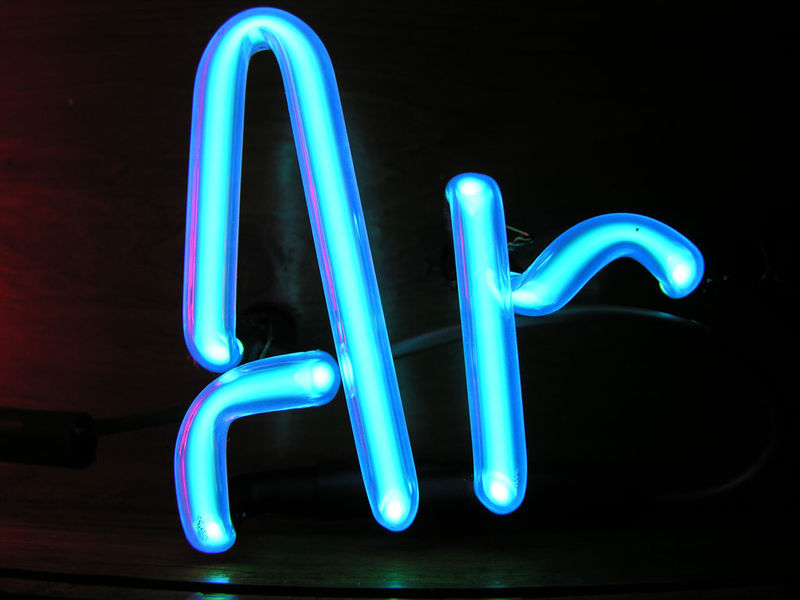 |
 |
 |
 |
 |
Noble gases are often used used in neon
signs; argon produces a blue color. The colors produced
by Argon (Ar), Helium (He), Kryton (Kr), Neon (Ne) and Xenon
(Xe), which are also noble gases, are shown above (source of
the images). This picture wasn't shown
in class.
Here's something
else I didn't show in class. It's
a longer and more complete list of the gases found in
air. Trying to remember the 5 most abundant gases in air
is reasonable. A long list like this is
overwhelming. Another problem with a list
like this is that it's for dry air so water vapor doesn't even
appear in the main list (it's at the very bottom of the
figure).
this table is from a Wikipedia article about the earth's atmosphere
| ppmv: parts per million by volume (note: volume fraction is equal to mole fraction for ideal gas only, see volume (thermodynamics)) | |
| Gas | Volume |
|---|---|
| Nitrogen (N2) | 780,840 ppmv (78.084%) |
| Oxygen (O2) | 209,460 ppmv (20.946%) |
| Argon (Ar) | 9,340 ppmv (0.9340%) |
| Carbon dioxide (CO2) | 394.45 ppmv (0.039445%) |
| Neon (Ne) | 18.18 ppmv (0.001818%) |
| Helium (He) | 5.24 ppmv (0.000524%) |
| Methane (CH4) | 1.79 ppmv (0.000179%) |
| Krypton (Kr) | 1.14 ppmv (0.000114%) |
| Hydrogen (H2) | 0.55 ppmv (0.000055%) |
| Nitrous oxide (N2O) | 0.325 ppmv (0.0000325%) |
| Carbon monoxide (CO) | 0.1 ppmv (0.00001%) |
| Xenon (Xe) | 0.09 ppmv (9×10−6%) (0.000009%) |
| Ozone (O3) | 0.0 to 0.07 ppmv (0 to 7×10−6%) |
| Nitrogen dioxide (NO2) | 0.02 ppmv (2×10−6%) (0.000002%) |
| Iodine (I2) | 0.01 ppmv (1×10−6%) (0.000001%) |
| Ammonia (NH3) | trace |
| Not included in above dry atmosphere: | |
| Water vapor (H2O) | ~0.40% over full atmosphere, typically 1%-4% at surface |
this table is from a Wikipedia article about the earth's atmosphere
Now let's go back to the
picture of the liquid nitrogen.


Let's be sure we know what we can and can't
see. Here's a figure to help with that.
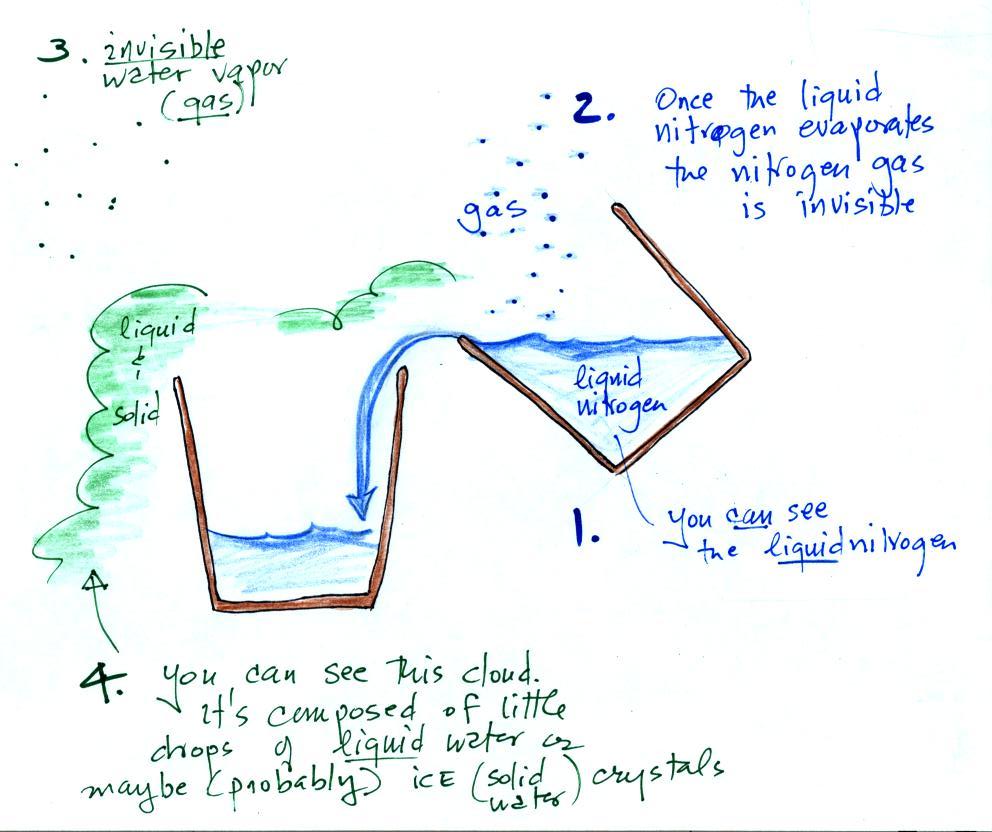
1 - We can see the liquid nitrogen, it's the clear liquid. But it's evaporating and producing nitrogen gas. 2 - We can't see the nitrogen gas.
What's producing the white cloud in the photo? 3 - That isn't water vapor because water vapor, a gas, is invisible just like nitrogen gas. When the air is cooled however, by coming into contact with the liquid nitrogen, the water vapor condenses and forms small droplets of water (liquid) or ice crystals (solid). 4 - That's what you are able to see, a cloud composed of water droplets or ice crystals.
Water plays an important role in the formation of clouds, storms, and weather. Meteorologists are very interested in knowing and keeping track of how much water vapor is in the air at a particular place and time. One of the variables they use is the dew point temperature. The value of the dew point gives you an idea of how much water vapor is actually in the air. The higher the dew point value, the more water vapor the higher the water vapor concentration.

1 - We can see the liquid nitrogen, it's the clear liquid. But it's evaporating and producing nitrogen gas. 2 - We can't see the nitrogen gas.
What's producing the white cloud in the photo? 3 - That isn't water vapor because water vapor, a gas, is invisible just like nitrogen gas. When the air is cooled however, by coming into contact with the liquid nitrogen, the water vapor condenses and forms small droplets of water (liquid) or ice crystals (solid). 4 - That's what you are able to see, a cloud composed of water droplets or ice crystals.
Water plays an important role in the formation of clouds, storms, and weather. Meteorologists are very interested in knowing and keeping track of how much water vapor is in the air at a particular place and time. One of the variables they use is the dew point temperature. The value of the dew point gives you an idea of how much water vapor is actually in the air. The higher the dew point value, the more water vapor the higher the water vapor concentration.

The chart below gives a rough equivalence between dew point temperature and percentage concentration of water vapor in the air.
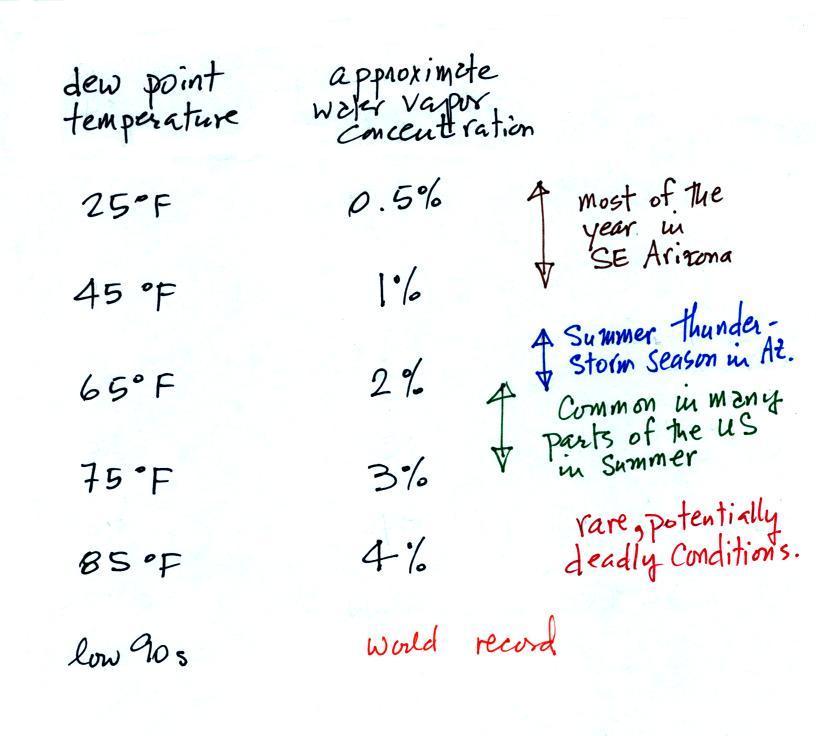
Air temperature will always be equal to or warmer than the dew point temperature. Experiencing 80o dew points would be very unpleasant and possibly life threatening because your body might not be able to cool itself ( the air temperature would probably be in the 90s or maybe even warmer). Here's an interesting link concerning unusually high, even record setting dew point temperatures.
Click here to see current dew point temperatures across the U.S.
Don't worry about remembering all these numbers. Just remember that the higher the dew point temperature the more water vapor is in the air and vice versa.
That's as far as we were able to get on the first day of class. We'll finish this topic in class on Friday.
One last thing.
A student came up after class and asked what she might need to know, about the material covered in class today, for a quiz. A lot of students are probably wondering the same thing.
I will put a study guide online before all of the quizzes this semester. Here's a small piece of the Practice Quiz Study Guide from the Fall 2012 semester.
Composition of the atmosphere. The five most abundant gases in the atmosphere (listed here in alphabetical order): argon (Ar), carbon dioxide (CO2), nitrogen (N2), oxygen (O2), and water vapor (H2O) (you should know approximate concentrations of all but CO2). Greenhouse gases: water vapor (H2O), carbon dioxide (CO2) and others. What do they do? What weather variable is commonly used to measure atmospheric water vapor content? Typical values of that variable in Tucson during the year.
You should be able to answer all of these questions at this point.